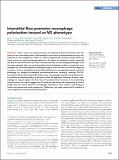| dc.contributor.author | Serrano, Jean Carlos | |
| dc.contributor.author | Zaman, Muhammad | |
| dc.contributor.author | Li, Ran | |
| dc.contributor.author | Xing, Hao | |
| dc.contributor.author | Lee, Tara A. | |
| dc.contributor.author | Azizgolshani, Hesham | |
| dc.contributor.author | Kamm, Roger Dale | |
| dc.date.accessioned | 2018-12-07T14:58:59Z | |
| dc.date.available | 2018-12-07T14:58:59Z | |
| dc.date.issued | 2018-07 | |
| dc.date.submitted | 2018-03 | |
| dc.identifier.issn | 1059-1524 | |
| dc.identifier.issn | 1939-4586 | |
| dc.identifier.uri | http://hdl.handle.net/1721.1/119458 | |
| dc.description.abstract | Tumor tissues are characterized by an elevated interstitial fluid flow from the tumor to the surrounding stroma. Macrophages in the tumor microenvironment are key contributors to tumor progression. While it is well established that chemical stimuli within the tumor tissues can alter macrophage behaviors, the effects of mechanical stimuli, especially the flow of interstitial fluid in the tumor microenvironment, on macrophage phenotypes have not been explored. Here, we used three-dimensional biomimetic models to reveal that macrophages can sense and respond to pathophysiological levels of interstitial fluid flow reported in tumors (∼3 μm/s). Specifically, interstitial flow (IF) polarizes macrophages toward an M2-like phenotype via integrin/Src-mediated mechanotransduction pathways involving STAT3/6. Consistent with this flow-induced M2 polarization, macrophages treated with IF migrate faster and have an enhanced ability to promote cancer cell migration. Moreover, IF directs macrophages to migrate against the flow. Since IF emanates from the tumor to the surrounding stromal tissues, our results suggest that IF could not only induce M2 polarization of macrophages but also recruit these M2 macrophages toward the tumor masses, contributing to cancer cell invasion and tumor progression. Collectively, our study reveals that IF could be a critical regulator of tumor immune environment. | en_US |
| dc.description.sponsorship | National Institutes of Health (U.S.) (Grant U01-CA214381) | en_US |
| dc.publisher | American Society for Cell Biology | en_US |
| dc.relation.isversionof | http://dx.doi.org/10.1091/mbc.E18-03-0164 | en_US |
| dc.rights | Creative Commons Attribution-NonCommercial share-alike 3.0 Unported | en_US |
| dc.rights.uri | http://creativecommons.org/licenses/by-nc-sa/3.0/ | en_US |
| dc.source | American Society for Cell Biology | en_US |
| dc.title | Interstitial flow promotes macrophage polarization toward an M2 phenotype | en_US |
| dc.type | Article | en_US |
| dc.identifier.citation | Li, Ran et al. “Interstitial Flow Promotes Macrophage Polarization Toward an M2 Phenotype.” Edited by Valerie Marie Weaver. Molecular Biology of the Cell 29, 16 (August 2018): 1927–1940 © 2018 Li et al. | en_US |
| dc.contributor.department | Massachusetts Institute of Technology. Department of Biological Engineering | en_US |
| dc.contributor.department | Massachusetts Institute of Technology. Department of Mechanical Engineering | en_US |
| dc.contributor.mitauthor | Li, Ran | |
| dc.contributor.mitauthor | Xing, Hao | |
| dc.contributor.mitauthor | Lee, Tara A. | |
| dc.contributor.mitauthor | Azizgolshani, Hesham | |
| dc.contributor.mitauthor | Kamm, Roger Dale | |
| dc.relation.journal | Molecular Biology of the Cell | en_US |
| dc.eprint.version | Final published version | en_US |
| dc.type.uri | http://purl.org/eprint/type/JournalArticle | en_US |
| eprint.status | http://purl.org/eprint/status/PeerReviewed | en_US |
| dc.date.updated | 2018-12-05T18:46:29Z | |
| dspace.orderedauthors | Li, Ran; Serrano, Jean Carlos; Xing, Hao; Lee, Tara A.; Azizgolshani, Hesham; Zaman, Muhammad; Kamm, Roger D. | en_US |
| dspace.embargo.terms | N | en_US |
| dc.identifier.orcid | https://orcid.org/0000-0003-4682-9677 | |
| dc.identifier.orcid | https://orcid.org/0000-0002-7232-304X | |
| mit.license | PUBLISHER_CC | en_US |
